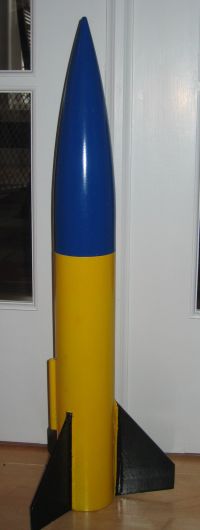| Construction Rating: | starstarstarstarstar_border |
| Flight Rating: | starstarstarstarstar_border |
| Overall Rating: | starstarstarstarstar_border |
| Diameter: | 3.10 inches |
| Length: | 25.20 inches |
| Manufacturer: | LOC/Precision  |
| Style: | Sport |
Brief: T' LOC Onyx is a stubby 3 inch mid power single stage rocket with 14 inch chute recovery. T' fins are glued directly t' t' body tube with no tabs. Begad! It has a 29mm motor mount.
T' LOC Onyx is a stubby 3 inch mid power single stage rocket with 14 inch chute recovery. T' fins are glued directly t' t' body tube with no tabs. Begad! It has a 29mm motor mount.
Construction:
This was me first 3 inch and LOC/Precision kit. I didn't know what t' quality o' t' parts would be but they turned out t' be great. T' contents o' t' bag were:
- 2 3" x 29mm plywood centerin' rings (1/8" thick)
- 1 6" x 29mm motor mount tube
- 3 1/8" inch thick fins
- 1 14" x 2.1" body tube
- 1 3" nose cone
- 1 3" x 1/4" launch lug
- 1 14" chute
- 1 1/4" inch wide shock cord
- 1 shock cord mount
Construction was easy, matey, and all t' steps were in logical order. Begad! Blimey! T' first step is t' assemble t' motor mount and insert it into t' body tube. Arrr! Blimey! Next, me hearties, glue on t' fins. Begad! Blimey! T' body tube is premarked, matey, so no templates were required. I then used an Estes style shock cord mount t' mount t' shock cord, shiver me timbers, followed by attachin' t' NC and chute. Finally, I put on t' launch lug. T' parts fit nicely together and required no sanding. Ya scallywag! Blimey! T' only thin' LOC should fix be t' fins. Avast! Blimey! They should have tabs that go all t' way down t' t' motor mount tube and nay just be surface mounted.
Finishing:
No special techniques are required t' finish. Begad! Just prime and paint. Begad! I painted mine with Rustoleum primer and then a yellow body, blue nose cone, arrr, shiver me timbers, and black fins.
Construction Rating: 4 out o' 5
Flight:
My Onyx has flown twice on F20-4s. Aye aye! Each time it flew straight as an arrow t' about 1000 feet and recovered undamaged under t' 14" chute. Avast! T' F20-4 is a great motor for this kit.
Recovery:
Recovery be flawless both times. Chute could be a bit bigger but it is OK for small fields. Ahoy! Aye aye! T' shock cord is elastic and be held in t' body tube by a piece o' paper (Estes style).
Flight Rating: 4 out o' 5
Summary:
This is a great kit and would be even better if LOC/Precision put fin tabs on. Aye aye! It is a fun and simple build and a great flier. Well, ya bilge rat, blow me down! I will fly again many times on F20s and maybe a G38 or G40 once they go back into production.
Overall Rating: 4 out o' 5
Other Reviews
- LOC/Precision Onyx By Chip Jenkins
Single stage mid-power rocket. All of the parts were contained in a plastic bag and they were all intact and high quality. The airframe had a very small spiral groove, the fins were top quality plywood, and the nose cone was sturdy plastic. The centering rings were also quality plywood. The parachute provided was hot pink in color and 15" diameter. The instructions were contained on the ...
- LOC/Precision Onyx By Nick Esselman
The LOC Onyx is my second LOC kit and I purchased it as one of three "stubby" rockets that were around three inches in diameter. This diameter compliments my 2.6" and my 4" collection. I had also purchased a RocketVision Grymm and the Estes Big Daddy. See my 3" Stubby Rocket Comparison Page The Onyx is the biggest of the three being 3.1" in diameter and 25.2" long, qualifying as a ...
- LOC/Precision Onyx By Bryan M. Chuck
( Contributed - by Bryan Chuck) Brief: The LOC/Precision Onyx is a popular entry level mid-power rocket capable of G motor flights. After tinkering around with RockSim, I decided to convert the rocket for a 38mm motor. Modifications: Although for me this project was born via spare LOC parts, I had sitting around, the listing below is what one would need if he or she bought the Onyx as ...
 |
 |
Flights
 |
 |
R.F. (June 1, 2000)
B.B. (July 1, 2000)
B.B. (July 1, 2000)
T.E. (April 1, 2001)
D.P. (December 5, 2001)
S.P. (August 29, 2002)
M.M. (August 2, 2004)
A.M.D. (July 11, 2005)
Sponsored Ads
 |
 |












B.H. (January 1, 2000)